Dongsheng Explains No.2 | April 2023
Tianxia: All Under Heaven
Tianxia (天下, tiānxià) or “all under heaven” is a concept that can be traced back four thousand years. Its appearance as a major category of Chinese thought only began in the early Warring States period (475-221 BCE). Tianxia is a complex, contested, and constantly-evolving concept. It embodies a range of meanings, from geography (demarcating a governed territory), to morality (defining political legitimacy), to subjectivity (representing the aspirations of the people), to politics (providing a vision for a world system), and much more. Much like the southern African philosophy of ubuntu (“humanity”) or the Latin American concept of buen vivir (“living well” or “life in harmony” ), tianxia centers on an understanding of the interconnectedness of all life and the betterment of our world community as a whole.
What is the meaning of tianxia? What makes the concept so enduring through millennia? And most importantly, what possibilities does it hold to help confront some of the greatest challenges that China and the world face today?
Why did the concept of tianxia emerge?
During the Eastern Zhou (771-256 BCE), a tumultuous period of constant conflict between states in China, tianxia had a territorial meaning; it represented a land mass of many countries governed by the “Son of Heaven” (天子, tiānzǐ). The ancient Chinese did not know for certain the size of tianxia – the various states’ territory amounted to less than half of today’s China’s – but they had no doubt they were at the center of civilization. Ancient documents tracing back to the Shang dynasty’s (1600-1066 BCE) sage-rulers suggest that tianxia did not only refer to a land mass, but also served as a political vision for an ideal world of harmony amongst states.
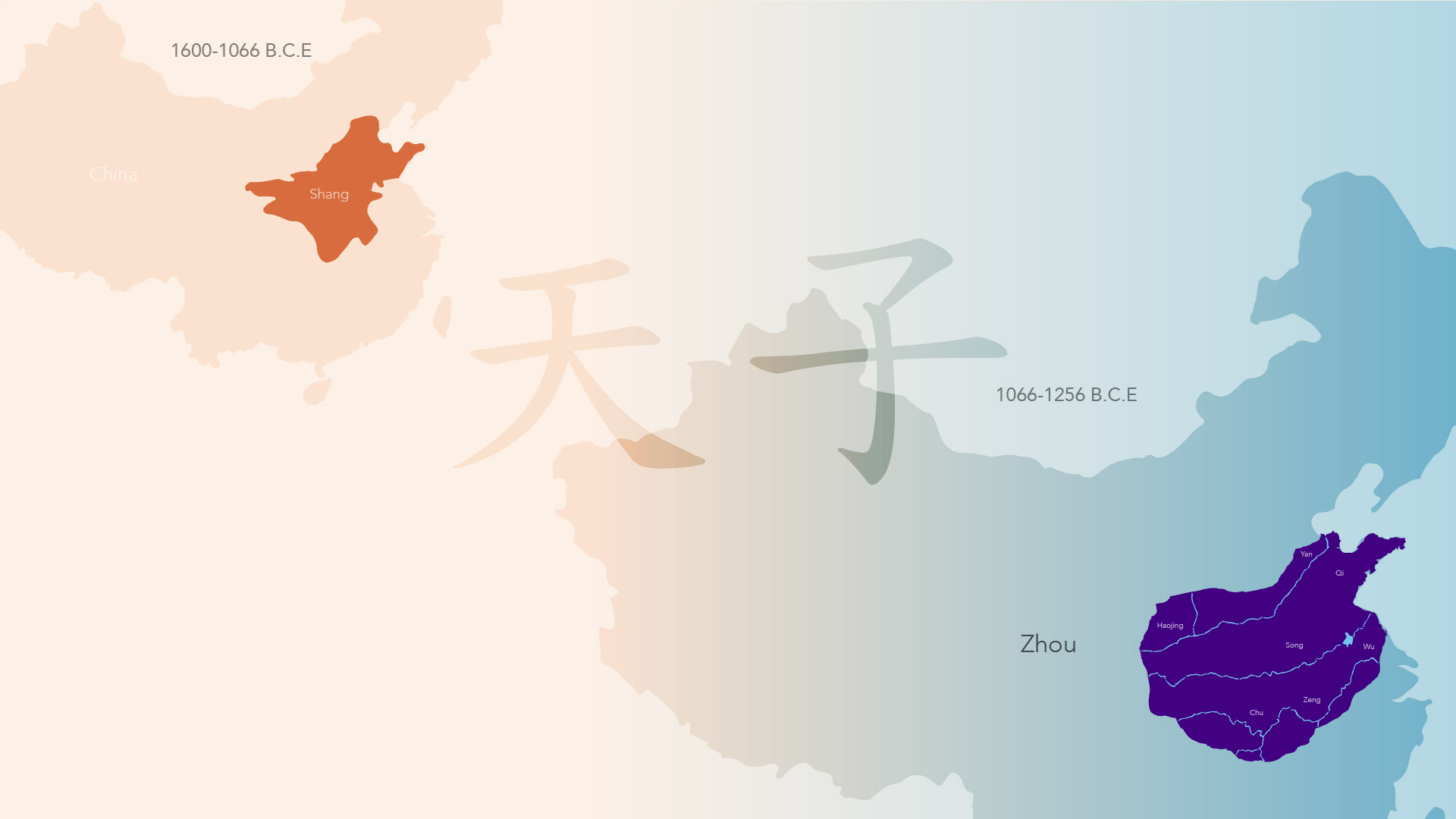
In the Zhou dynasty (1066-256 BCE), a period of huge unrest and military conflict, tianxia was institutionalized, transforming it from a political vision into a system of governance. This system is defined by three elements: The first is that the tianxia system must guarantee that all states involved receive more benefits through their participation than by remaining independent. Secondly, the system relies on mutual dependency and reciprocity among all of the states. Finally, the tianxia system must develop a set of common interests, beliefs, and projects to ensure its universally-shared character.
What is the “heavenly mandate”?
Under tianxia, political power comes from tianming (天命, tiānmìng), a “heavenly mandate” or “heavenly-invoked order”. This mandate, however, is neither eternal, divinely-granted, nor solely based on military or economic might. During the ancient Shang dynasty (1600-1066 BCE), this mandate was thought to come from the will of heaven, or “the God in Heaven” or shangdi (上帝, shàngdì). Shangdi was not a monotheistic deity, and was linked to the spirits of tribal ancestors. From the Zhou dynasty onwards, this heavenly mandate turned its focus towards the people, specifically, the “shared aspirations of the people” or minxin (民心, mínxīn). In order to claim political legitimacy, a ruler must have earned the support of the tianxia’s people. The loss of minxin is justification for revolt and revolution. The rise and fall of dynasties, spurred by peasant rebellions to mass natural disasters and military mutinies, represent this loss in the heavenly mandate, and thereby the rulers’ political legitimacy.
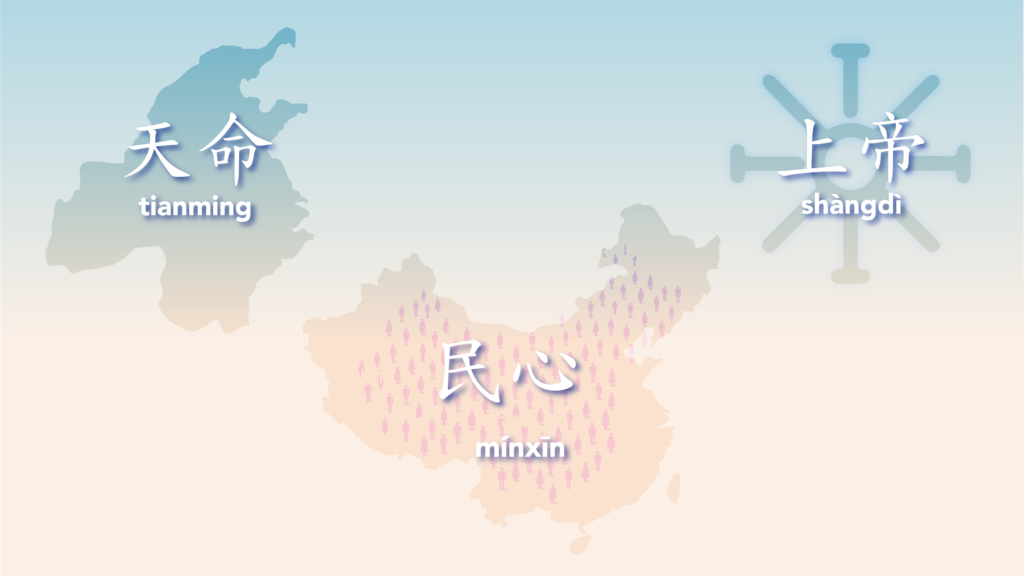
How does tianxia differ from Western concepts of governance?
The tianxia system emerges from a history quite distinct from other ancient models of an empire or statehood, such as the Greek Republic or the European nation-state. The Greek system, for example, centered around the idea of the polis, or the city-state, and is one of national politics where there is a clear distinction between states, between private life and a public realm, and between the individual and the state. Conversely, the idea of tianxia has neither an “inside” nor “outside”, but defines an all-inclusiveness joined together by the rule of the Son of Heaven. The political framework of Western civilizations is based on a structure in which the individual is the basic political subject and the nation-state – often ethnically-defined – is the largest sovereign political unit. However, according to Chinese political philosophy, the family – rather than the individual – is the smallest political unit, with tianxia as the highest level, transcending the level of the state.
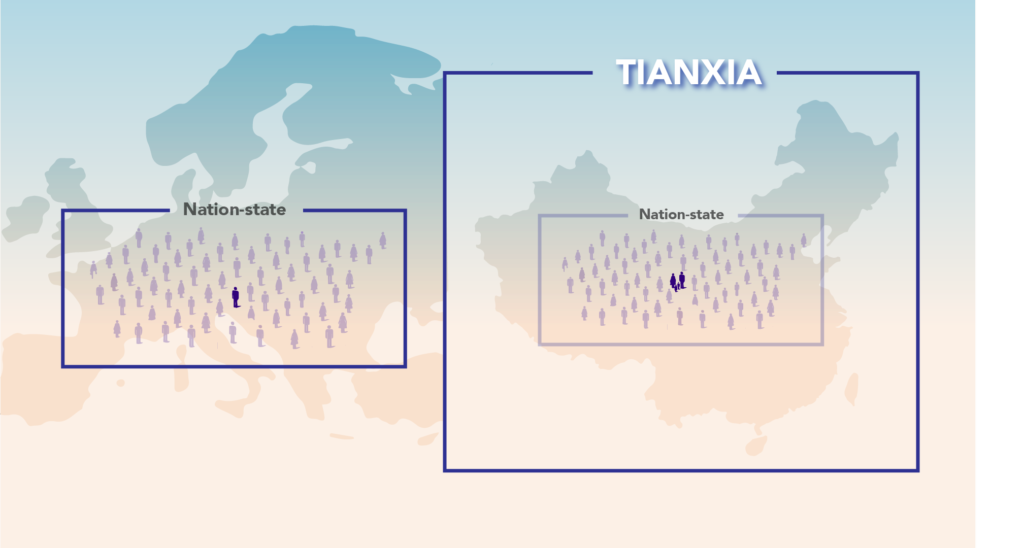
In the conception of tianxia, each individual has responsibility and relationality to a greater humanity. In the Confucian tradition, the individual is emphasized primarily in the highly-valued practice of learning and self-cultivation in the service of the family, the state, and the world – a tradition that has been incorporated by the Chinese communists in the praxis of “criticism and self-criticism”. Tianxia was not only articulated in the Confucian tradition, but extended to other Chinese schools of thought. For example, Mozi (c.470-391 BCE)(墨子, mòzi), founder of Mohism during the Hundred Schools of Thought (百家争鸣, bǎijiā zhēngmíng) period, is one of the Chinese philosophers who wrote the most about tianxia, using this word over four hundred times in his works. Later texts by Mencius, Xunzi (荀子, xúnzi), and Han Feizi (韩非子, hánfēizi) referred to the common cultural ideal of a unified territory with a single ruler.

According to Confucius, the tianxia system is voluntary and non-coercive. States outside of tianxia can participate in the system if they deem it to be beneficial to them, as long as they voluntarily follow the tianxia system’s frameworks and standards, i.e., “forms and norms” (礼乐, lǐyuè, which literally means rites and music). Confucius suggested that the way to attract people outside the tianxia system is to satisfy the needs of the people already within it.
What is the role of multi-ethnic unity in tianxia?
In 221 BCE, tianxia was finally unified with Qin Shi Huang (or “the first emperor of the Qin empire”) (秦始皇, qínshǐhuáng) as its ruler. The Han dynasty that followed (202 BCE–220 CE), then built the empire model into a prototype of China’s modern nation-state, or a forebear of the China we know more than two thousand years later. However, the concept of tianxia originated much earlier than those dynasties, and was never understood as a narrow ethnic concept centered around “the Han people.” Today, the Han people – one of China’s 56 official ethnicities – comprise 92 percent of the population, but this identity was an invention of the times, as people began to self-identify with the “golden age” Han dynasty. Tianxia is not only a political concept defined by states borders , but also a cultural concept defined by forms and norms. Ethnic groups in the periphery are welcomed, but are not forced to follow those forms and norms or become part of the tianxia system; they also bring innovations into the system. This dynamic process has continued for two thousand years and has shaped the multi-ethnic society of China today.
How does tianxia help us understand modern China?
This concept of tianxia helps in understanding the emergence of modern China, which has been able to maintain relative territorial integrity and resist dissolution, despite diversity and differences. In the early modern period of the 19th century, during a period of continuous decline of the Qing dynasty (1644-1911) due to imperialist incursions, warlordism, and economic decline, many scholars sought out new ideas to transform Chinese society. Kang Youwei (1858-1827), a Confucian reformer and a key figure behind the Hundred Days’ Reform (百日维新, bǎirì wéixīn) in 1898, looked to the Confucius classics. He wrote the Book of Great Unity (大同书, dàtóng shū), which was posthumously published in 1935, in which he divided the world’s development into three stages: an “uncivilized” stage, an intermediate or xiaokang (小康, xiǎokāng) stage, and the final stage of great unity (太平世, tàipíng shì). According to Kang Youwei, who supported the restoration of the monarchy but rejected the Western nation-state model, the highest goal was the abolishment of states and inequality, creating a world in common by all (天下为公, tiānxià wèigōng).

Sun Yat-sen (1866-1925), founding father of the modern Chinese nation, helped overthrow the last imperial dynasty of the Qing with the 1911 Xinhai Revolution. Rather than turning away from the Confucian tradition at large, like Kang Youwei, he mobilized support to establish the Republic of China under the banner of “a world in common by all ” (天下为公, tiānxià wèigōng) – a new republican interpretation of the “heavenly principle”. Rather than dissolve the structures and ideas of the imperial dynasties, the transition from empire to a modern state drew from, modified, and built on the past – from Confucian principles like tianxia to the centralized bureaucratic governance to the meritocratic education and examination systems.
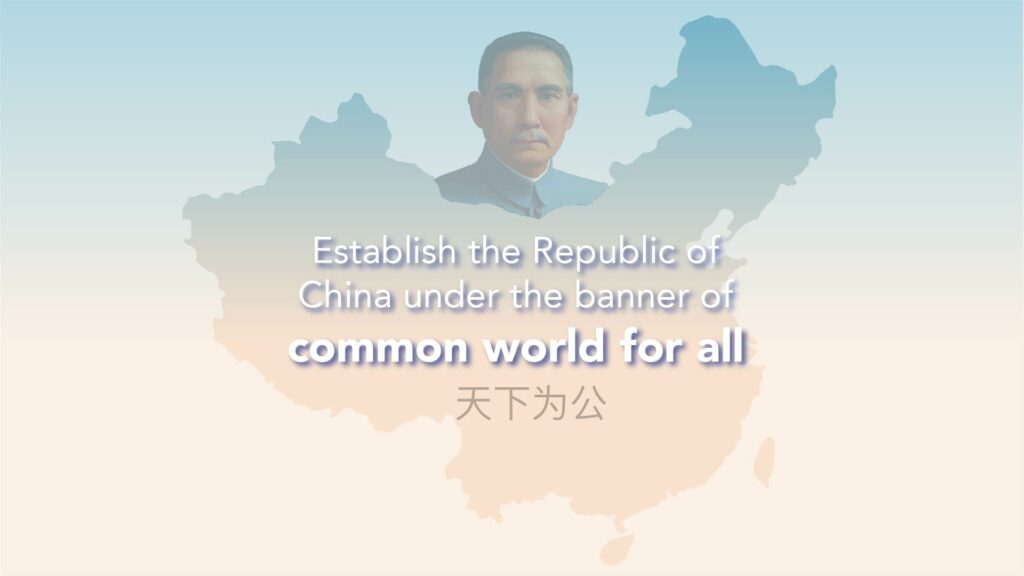
What is the relationship between Marxism and tianxia?
As national consciousness awakened, particularly sparked by the anti-imperialist and anti-feudal May Fourth Movement of 1919, Marxist ideas bloomed and inspired the formation of the Communist Party of China and associated mass movements and organisations. During the war of resistance against Japanese aggression, Mao already understood that for Marxism-Leninism to take root in China, it must take on a Chinese character. In The Role of the Chinese Communist Party in the National War (1938), he wrote, “Our national history goes back several thousand years and has its own characteristics and innumerable treasures. But in these matters we are mere schoolboys. Contemporary China has grown out of the China of the past; we are Marxist in our historical approach and must not lop off our history. We should sum up our history from Confucius to Sun Yat-sen and take over this valuable legacy” (published in 1965). From Sun Yat-sen’s vision of “Five Races, One Republic” – Han, Manchu, Mongol, Hui, Tibetan – to Mao Zedong’s call for a grand unification of the peoples of all ethnicities in the establishment of the People’s Republic of China, a clear connection can be seen with the long tradition of state-building based on the unity and rule of all under heaven.
Mao Zedong also pointed out that all empires in history went through the cycle of gaining and losing tianxia, which led to their demise. To end this historical cycle, the CPC should act under the guidance of Marxism. In 1945, Mao emphasized that “the ruling party should accept the supervision of the people”. Seventy-seven years later, Xi Jinping said that the ruling party should constantly revolutionize itself in order to avoid this historical cycle. According to Marx, one of the fundamental things that distinguishes the proletarian revolution from other revolutions is the process of self-criticism, by which it continually strengthens itself. By innovating on Marx’s theory and combining it with China’s history, the CPC and its leaders have given a new meaning to “owning tianxia“.
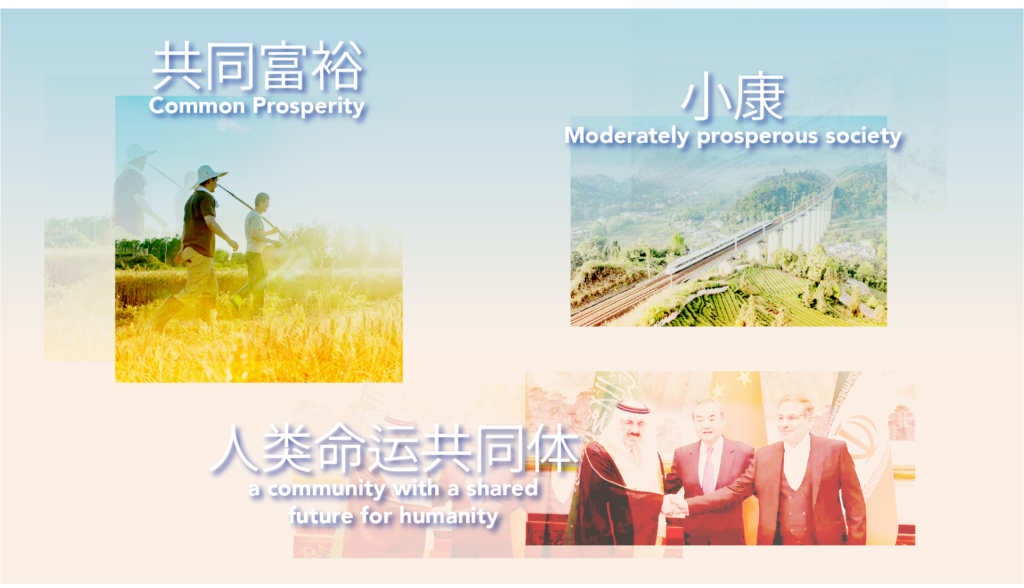
What is tianxia’s relevance today?
At the end of 2020, with the eradication of extreme poverty, China entered the period of xiaokang – or a moderately prosperous society – one of the two centenary goals of the Communist Party of China. It is not a coincidence that the Confucian term of xiaokang, or the age of rising peace, was chosen. The current vision, laid out by the government for its domestic policy, is “common prosperity” (共同富裕, gòngtóng fùyù), and for the world is a “a community with a shared future for humanity” (人类命运共同体, rénlèi mìngyùn gòngtóngtǐ), both sharing strong associations with the spirit embodied by the Confucian – and communist – vision of a world in great unity (天下大同, tiānxià dàtóng). Both political visions point toward a more just world in which the wealth of tianxia is more evenly shared among its inhabitants, between the North and South, the developed and the underdeveloped countries, the rich and the poor.
Subscribe. Donsheng Explains is published monthly in English, Spanish and Portuguese.
Follow our social media channels:
- Twitter: @DongshengNews
- Telegram: News on China
- Instagram: @DongshengNews
- YouTube: Dongsheng News
- Facebook: Dongsheng News
- TikTok: @dongshengnews





